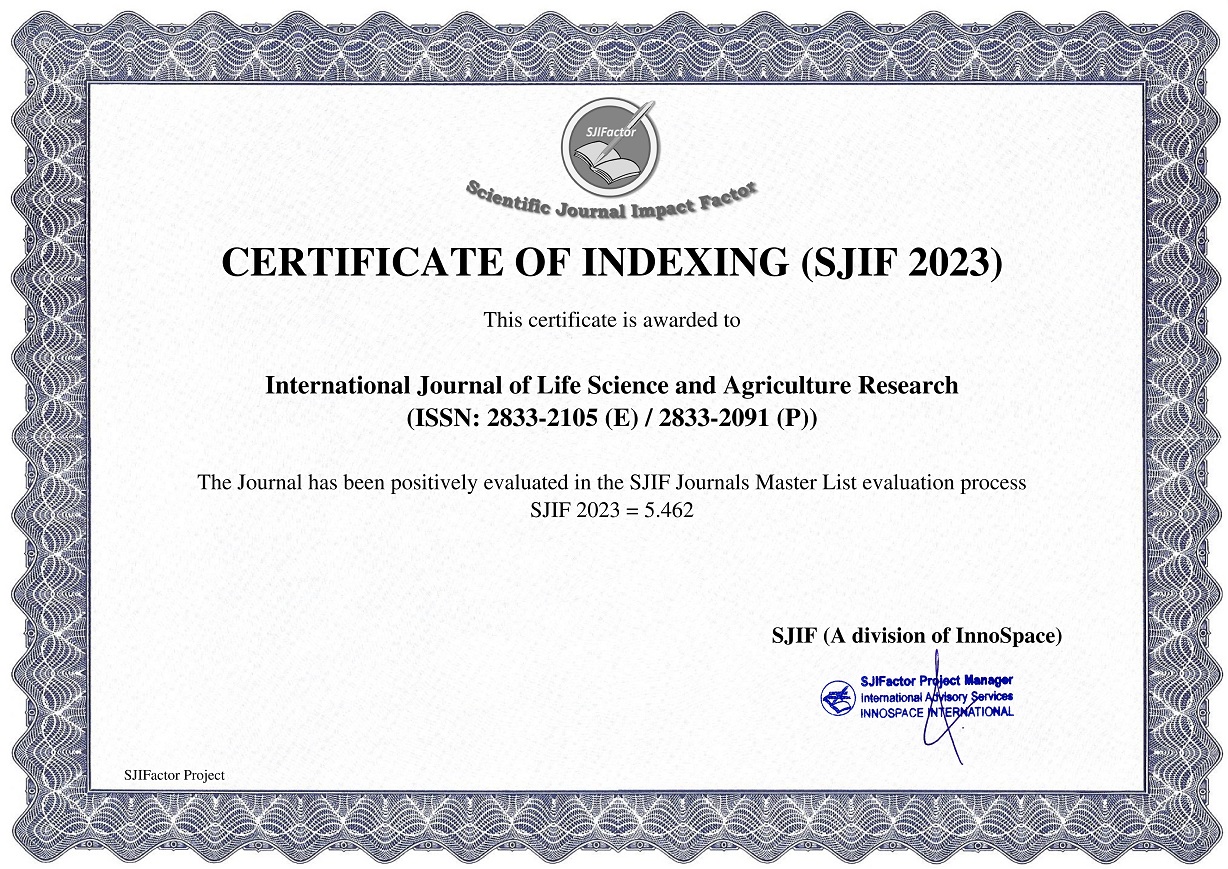Concept and Transmission of Microplastics in Human Diet
DOI:
https://doi.org/10.55677/ijlsar/V02I04Y2023-03Keywords:
Concept, microplastics, sources, transmissionAbstract
Use of plastics for different purposes which are non-biodegradable in nature has made a serious problem to nature. The hotspot areas of plastic pollution are confined to the ocean, landfills and open waste disposals. Plastics which fragments into small pieces in the size range of 0.001 - 5 mm are termed as microplastics. Microplastics can enter the environment through agricultural run-off, tyre and road-wear particles, wear and tear of clothes, plastic packages, industrial effluents, microbeads, etc. it can also transfer into the food chain through soil, seaweed, seasalt, drinking water, bottled water, processed food products, packaging, etc. The problems created by microplastics are of great concern for living beings.
References
Barboza, L. G. A., Frias, J. P. G. L., Booth, A.M., Vieria, L. R., Masura, J., Baker, J., Foster, G. and Guilhermino, L.M. (2018). Marine pollution by microplastics: environmental contamination, biological effects and research challenges. In: Sheppard, C.R.C. (Edition), World Seas: An environmental evaluation. 329-351.
Carbery, M., Connor, W.A. and Palanisami, T. (2018). Trophic transfer of microplastics and mixed contaminants in the marine food web and implications for human health. Environment International. 115: 1-10.
Catarino, A. I., Macchia, V., Sanderson, W. G., Thompson, R. C. and Henry, T. B. (2018). Low levels of microplastics in wild mussels indicate that MP ingestion by humans is minimal compared to exposure via household fibres fallout during a meal. Environmental Pollution. 237: 675-684.
Chatterjee, S. and Sharma, S. (2019). Microplastics in our oceans and marine health. The Journal of Field Actions. 19: 54-61.
Claessens, M., Meester, S.D., Landuyt, L.V., Clerck, K.D. and Janssen, C.R. (2011). Occurrence and distribution of microplastics in marine sediments along the Belgian coast. Marine Pollution Bulletin. 62 (10): 2199-2204.
Corradini, F., Meza, P., Equiluz, R., Casado, F., Huerta-Lwanga, E. and Geissen, V. (2019). Evidence of microplastic accumulation in agricultural soils from sewage sludge disposal. Science of the Total Environment. 671: 411-420.
Diaz-Basantes, M.F., Conesa, J.A. and Fullana, A. (2020). Microplastics in honey, beer, milk and refreshments in Equador as emerging contaminants. Sustainability. 12(5514): 1-17.
Fuller, S. and Gautam, A. (2016). A procedure for measuring microplastics using pressurized fluid extraction. Enironmental Science and Technology. 50: 5774-5780.
Gutow, L., Eckerlebe, A., Gimenez, L. and Saborowski, R. (2016). Experimental evalution of seaweeds as a vector for microplastics into marine food webs. Environmental Science and Technology. 50 (2): 915-923.
Henry, B., Laitala, K. and Klepp, I.G. (2019). Microfibers from apparel and home textiles: prospects for including microplastics in environmental suitability assessment. Science of the Total Environment. 652: 483-494.
Huerta-Lwanga, E., Mendoza-Vega, J., Ku-Quej, V., Angeles-Chi, J., Cid, L.S., Chi, C., Segura, G.E., Gersten, H., Salanki, T., Ploeg, M., Koelmans, A.A. and Geissen, V. (2017). Field evidence for transfer of plastic debris along a terrestrial food chain. Scientific Reports. 7(14071): 1-8.
Kedzierski, M., Lechat, B., Sire, O., Le Maguer, G., Le Tilly, V. and Bruzaud, S. (2020). Microplastic contamination of packaged meat: Occurrence and associated risks. Food Packaging and Shelf life. 24: 1-6.
Kole, P.J., Lohr, A.J., Belleghem, F.G.A.J.V. and Ragas, M.J. (2017). Wear and tear of tyres: A stealthy source of microplastics in the environment. International Journal of Environmental Research and Public Health. 14(1265): 1-31.
Li, Q., Feng, Z., Zhang, T., Ma, C., Shi, H. (2020). Microplastics in the commercial seaweed nori. Journal of Hazardous Materials. 388(122060): 1-9.
Liebezeit, G. and Liebezeit, E (2013). Non-pollen particulates in honey and sugar. Food Additives and Contaminants. 30(12): 1-13.
Liebezeit, G. and Liebezeit, E (2014). Synthetic particles as contaminants in German Beers. Food Additives and Contaminants. 31(9): 1-8.
Mathlouthi, M. (2013). Food packaging and preservation US: Springer. https://books.google.fr/books?id=2gHTBWAAQBAJ
Mohlenkamp, P., Purser, A. and Thomsen, L. (2018). Plastic microbeads from cosmetic products: an experimental study of their hydrodynamic behavior, vertical transport and resuspension in phytoplankton and sediment aggregates. Elementa Science of the Anthropocene. 6(61): 1-16.
Muhlschlegel, P., Hauk, A., Walter, U. and Sieber, R. (2017): Lack of evidence for microplastic contamination in honey. Food Additives and Contaminants. 34(11): 1-7.
Reimonn, G., Lu, T., Gandhi, N. and Chen, W.T. (2019). Review of microplastic pollution in the environment and emerging recycling solutions. Journal of Renewable Materials. 7(12) : 1-18.
Renzi, M. and Blaskovic, A. (2018). Litter and microplastics features in table salts from marine origin: Italian versus Croatian brands. Marine Polution Bulletin. 135: 62-68.
Singh, K.D.P. and Mathur, A. (2019). Plastic pollution in India: An evaluation of public awareness and consumption behavior. International Journal of Sustainable Development. 12(7): 1-16.
Sobhani, Z., Lei, Y., Tang, Y., Wu, L., Zhang, X., Naidu, R., Megharaj, M. and Fang, C. (2020). Microplastics generated when opening plastic packaging. Scientific Reports. 10: 1-7
Syberg, K., Khan, F.R., Selck, H., Palmqvist, A., Banta, G.T., Daley, J., Sano, L. and Duhaime, M.B. (2015). Microplastics: Addressing ecological risk through lessons learned. Environmental Toxicology and Chemistry. 34 (5).
Teuten, E.L., Rowland, S.J., Galloway, T.S. and Thompson, R.C. (2007). Potential for plastics to transport hydrophobic contaminants. Environmental Science and Technology. 41(22): 7759-7764.
Verla, A.W., Enyoh, C.E. and Verla, E.N. (2019). Microplastics, an Emerging Concern: A review of analytical techniques for detecting and quantifying microplastic. Analytical Methods in Environmental Chemistry Journal. 2(2): 15-32.
Vogelsang, C., Sundor, I., Lusher, A. and Umar, M. (2018). Microplastics in road dust- characteristics, pathways and measures. Technical report. 1-174.
Wang, J., Tan, Z., Peng, J., Qiu, Q. and Li, M. (2016). The behaviors of microplastics in the marine environment. Marine Environmental Research. 113: 7-17.
World Health Organization (2019). Information sheet: Microplastics in drinking-water. https://www.who.int
Yang, D., Shi, H., Li, L., Jabeen, K. and Kolandhasamy, P. (2015). Microplastic pollution in table salts from China. Environmental Science and Technology. 49(22): 13622-13627.





